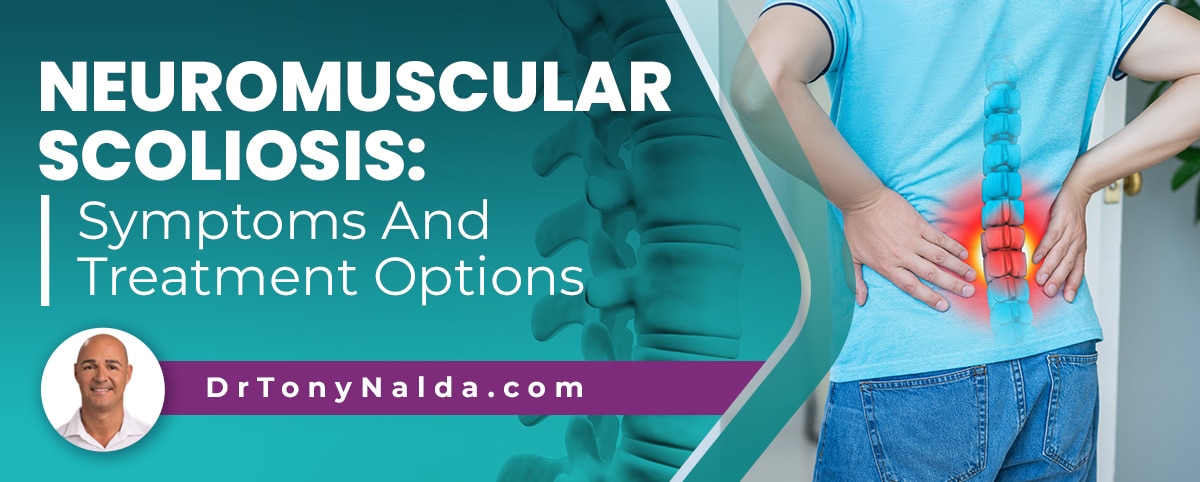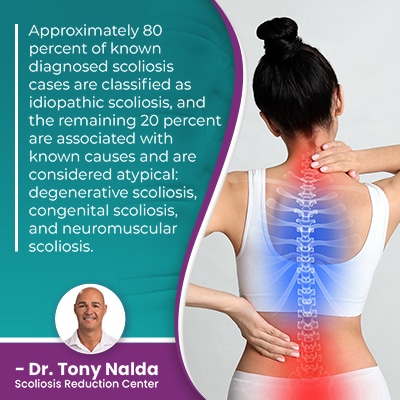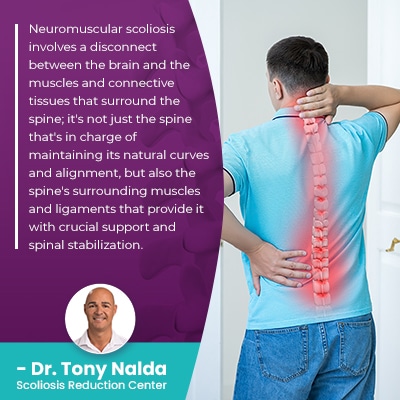Neuromuscular Scoliosis: Symptoms And Treatment Options

When scoliosis is diagnosed, it's further classified based on important patient and condition variables, one of which is condition type. Some types of scoliosis are considered atypical; neuromuscular scoliosis is one because it can involve a left-bending curve and a larger more-complex medical condition has caused the development of scoliosis as a related complication.
There are different types of scoliosis a person can be diagnosed with, and type is determined by a condition's underlying cause. Neuromuscular scoliosis (NMS) is caused by the presence of a larger neuromuscular condition, meaning the neuromuscular condition has to be the focus of treatment.
Before getting to the specifics of neuromuscular scoliosis, let's start with how scoliosis of any type is diagnosed.
Table of Contents
Diagnosing Scoliosis
A healthy spine is naturally curved at each of its main sections: the cervical spine (neck), the thoracic spine (middle/upper back), and the lumbar spine (lower back).
The spine's healthy curves is what makes it appear straight when viewed from the front and/or back, and gives it a soft 'S' shape when viewed from the sides.
Scoliosis is a highly-prevalent spinal condition that involves the development of an unnatural sideways curvature of the spine that also rotates, making it a 3-dimensional condition.
The loss of the spine's healthy curves makes it weaker, less flexible, and disrupt its ability to optimally absorb/distribute mechanical stress incurred during activity.
For an unnatural sideways-bending and twisting curve to be diagnosed as scoliosis, there is also a minimum curve-size requirement: minimum Cobb angle measurement of 10 degrees.
A patient's Cobb angle measurement involves an X-ray and drawing lines from the tops and bottoms of the curve's most-tilted vertebrae at its apex, and the resulting angle is expressed in degrees.
The more severe a condition, the higher the Cobb angle, and the more complex it's going to be to treat:
- Mild scoliosis: Cobb angle measurement of between 10 and 25 degrees
- Moderate scoliosis: Cobb angle measurement of between 25 and 40 degrees
- Severe scoliosis: Cobb angle measurement of 40+ degrees
- Very-severe scoliosis: Cobb angle measurement of 80+ degrees
Condition severity is a key factor that treatment plans are customized around; another key classification point is type, and this is determined by causation.
Classifying Scoliosis by Type
The different types of scoliosis are determined by what causes their development, and this is important because when treating a condition, if its underlying cause isn't addressed, this means the condition's symptoms are being treated, but not their underlying cause: the condition itself.
 The most common form of scoliosis to affect all ages is idiopathic scoliosis, and idiopathic means not clearly associated with a single-known cause.
The most common form of scoliosis to affect all ages is idiopathic scoliosis, and idiopathic means not clearly associated with a single-known cause.
Approximately 80 percent of known diagnosed scoliosis cases are classified as idiopathic scoliosis, and the remaining 20 percent are associated with known causes and are considered atypical: degenerative scoliosis, congenital scoliosis, and neuromuscular scoliosis.
In typical types of idiopathic scoliosis, the scoliotic curve bends to the right, away from the heart (dextroscoliosis), and in atypical types, the curve can bend to the left, towards the heart (levoscoliosis), and when I see this on an X-ray, I know there is an underlying pathology that's caused the scoliosis to develop.
Neuromuscular Scoliosis
Neuromuscular scoliosis (NMS) is a complex condition type, not only because cases tend to be more severe, but because the scoliosis has developed as a secondary complication caused by a larger neuromuscular condition.
There are many neuromuscular disorders capable of causing the development of neuromuscular scoliosis; some common conditions include cerebral palsy, spina bifida, and duchenne muscular dystrophy.
Neuromuscular scoliosis involves a disconnect between the brain and the muscles and connective tissues that surround the spine; it's not just the spine that's in charge of maintaining its natural curves and alignment, but also the spine's surrounding muscles and ligaments that provide it with crucial support and spinal stabilization.
The severity of neuromuscular scoliosis is determined by the degree of neuromuscular involvement, so the more the spine's surrounding muscles, connective tissues, and nerves are affected, the more severe the condition is going to be.
Symptoms of Neuromuscular Scoliosis
Neuromuscular scoliosis diagnosed is a more-complex type of scoliosis because the underlying condition causing the scoliosis can be severe, making the scoliosis also more severe.
Neuromuscular conditions commonly affect the brain, spinal cord, and the muscular system, and depending on the neuromuscular condition, one, more than one, or all can be affected.
Because the brain and spinal cord work together to form the body's central nervous system, if a neuromuscular disease has affected these systems, the muscles and nerves that surround the spine are affected, and they are unable to help the spine maintain its natural and healthy curves, hence the development of scoliosis.
Symptoms are always case-specific, but the more a neuromuscular condition impairs a patient's movement and balance, the more likely it is to cause the development of scoliosis; having a neuromuscular condition doesn't guarantee the development of scoliosis, but it is a common complication that warrants awareness.
Cerebral palsy targets the body's musculoskeletal system and the ability to balance and engage in a wide range of movement; it's caused by damage that occurs as the brain is developing in utero.
Muscular dystrophy is a complex disorder with more than 30 types that degenerate and weaken the skeletal muscles engaged during balance and movement; some types are present at birth, while others develop during infancy and/or adolescence.
Spina bifida is the most common birth defect and develops in utero as the neural tube that later develops into the spinal cord and brain doesn't close properly.
So symptoms of neuromuscular scoliosis will vary from case to case based on severity and the type of neuromuscular condition present; in most cases, movement is impaired, and varying levels of back pain, and radiating pain into the extremities due to nerve compression are common symptoms.
 Children with neuromuscular scoliosis are more common than adults, and for patients whose neuromuscular condition has not made them wheelchair-bound (ambulatory patients), the following symptoms of NMS are similar to those of childhood idiopathic scoliosis:
Children with neuromuscular scoliosis are more common than adults, and for patients whose neuromuscular condition has not made them wheelchair-bound (ambulatory patients), the following symptoms of NMS are similar to those of childhood idiopathic scoliosis:
- Uneven shoulders and shoulder blades
- A rib cage arch with one side protruding more prominently than the other
- An uneven waistline
- Uneven hips
- A general asymmetrical appearance to the body
For patients whose neuromuscular conditions have caused them to become nonambulatory (wheelchair-bound and unable to walk on their own), the following symptoms can be common:
- Pelvic obliquity (tilted pelvis)
- Pressure sores from severe pelvic obliquity and imbalance
- Difficulty sitting due to imbalance
- Postural changes that include a slouching appearance and prominent lean to one side
- Varying levels of back and radiating pain
- Issues with pulmonary function
When cases of neuromuscular scoliosis are severe with large scoliotic curves, lung function can be affected by compression (uneven pressure) of the chest, heart, and lungs; in extreme cases, surgical treatment can be needed to relieve pressure on the lungs (chest expansion surgery).
Neuromuscular Scoliosis Treatment Options
When it comes to treating neuromuscular scoliosis, neuromuscular spinal deformities complicate the treatment process because the larger neuromuscular condition has to be the focus of treatment; in addition, these cases tends to be more severe and involve atypical left-bending spinal curves.
As a progressive condition, scoliosis has it in its nature to get worse over time, and when there is a larger medical condition driving the development of scoliosis, curve progression tends to also be more severe and occur faster, particularly in children with neuromuscular scoliosis who also have the progressive trigger of growth.
Regardless of the type of scoliosis, all conditions are progressive, and in order to treat neuromuscular scoliosis, the underlying cause needs to be addressed.
I can't give my neuromuscular scoliosis patients the same types of prognoses I can with my typical idiopathic scoliosis patients.
There are two main treatment options for neuromuscular scoliosis: surgical treatment and nonsurgical treatment.
Here at the Scoliosis Reduction Center, I offer nonsurgical treatments for a variety of spinal conditions and different types of scoliosis, neuromuscular scoliosis included; my treatment goal is to slow the progression of neuromuscular scoliosis and improve quality of life.
Conservative nonsurgical treatments include condition-specific chiropractic care, bracing, rehabilitation, and modified exercises, and while these are more effective on ambulatory patients, nonambulatory patients are more severe and tend to have larger curves that are more rigid and less responsive to treatment, so the focus is more on symptom management and condition improvement.
Surgical treatment for neuromuscular scoliosis commonly involves spinal fusion surgery that involves fusing the curve's most-tilted vertebrae and attaching metal rods to the spine to hold its position, which carries its own potential risks, side effects, and complications.
Conclusion
While I approach each case of scoliosis with a fresh perspective, the reality is that my neuromuscular scoliosis patients are often the most difficult to treat, and this is because the underlying neuromuscular condition has to be the focus of treatment.
Neuromuscular scoliosis is more common in children than adults, just as idiopathic scoliosis is more commonly diagnosed in children.
Neuromuscular conditions can cause a disconnect between the brain, the spine, and its surroundings, and this can disrupt the ability of the spine and its surrounding muscles and ligaments to provide it with support and spinal stabilization.
Due to the complex and severe nature of many neuromuscular scoliosis cases, the focus is on symptom management, slowing progression, increasing spinal stabilization, and improving overall quality of life.
Dr. Tony Nalda
DOCTOR OF CHIROPRACTIC
After receiving an undergraduate degree in psychology and his Doctorate of Chiropractic from Life University, Dr. Nalda settled in Celebration, Florida and proceeded to build one of Central Florida’s most successful chiropractic clinics.
His experience with patients suffering from scoliosis, and the confusion and frustration they faced, led him to seek a specialty in scoliosis care. In 2006 he completed his Intensive Care Certification from CLEAR Institute, a leading scoliosis educational and certification center.
About Dr. Tony Nalda
 Ready to explore scoliosis treatment? Contact Us Now
Ready to explore scoliosis treatment? Contact Us Now





